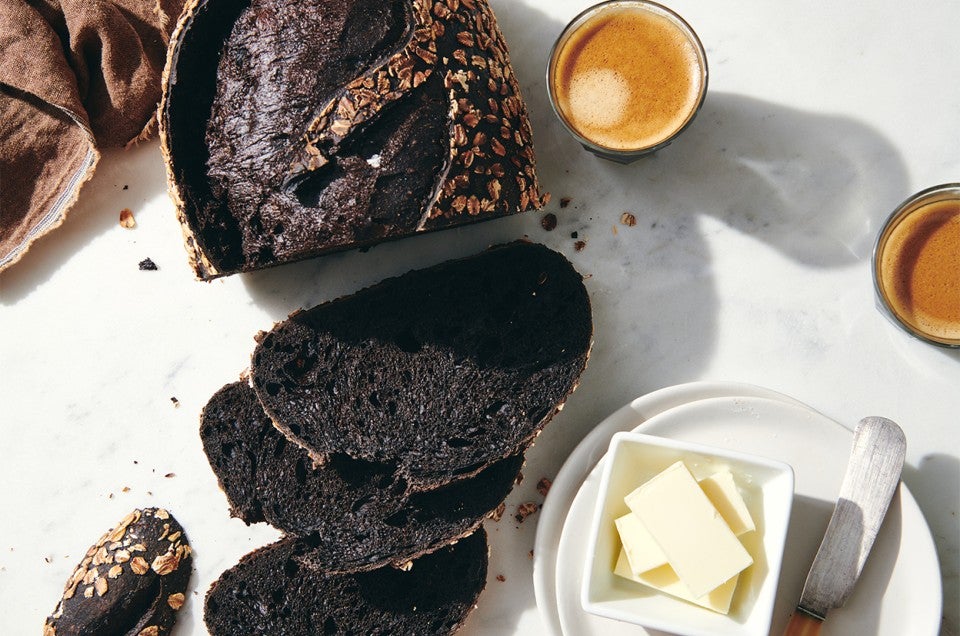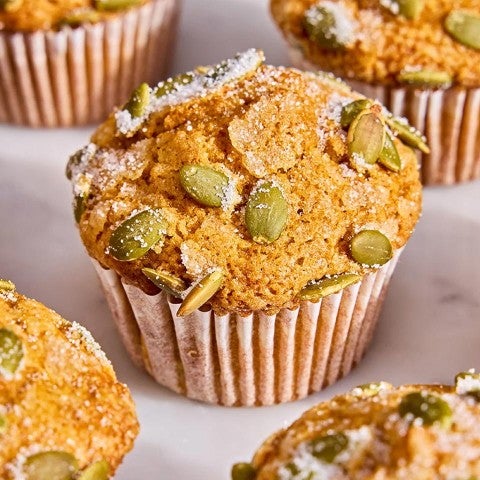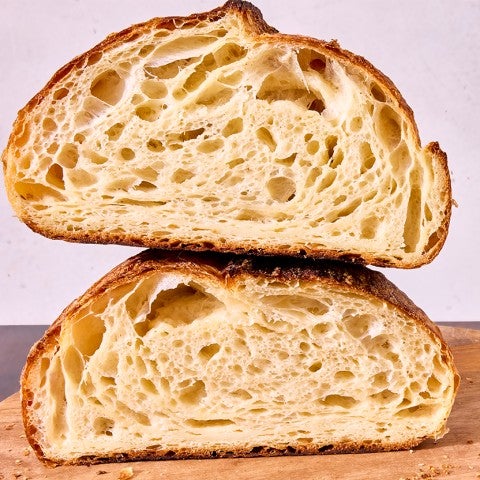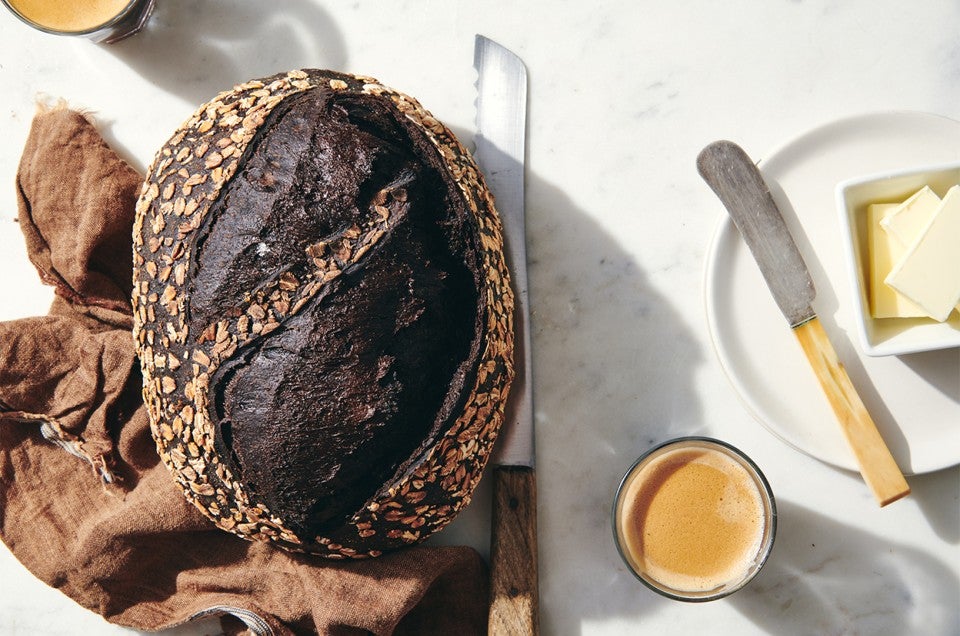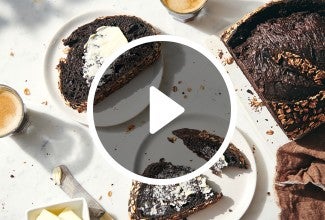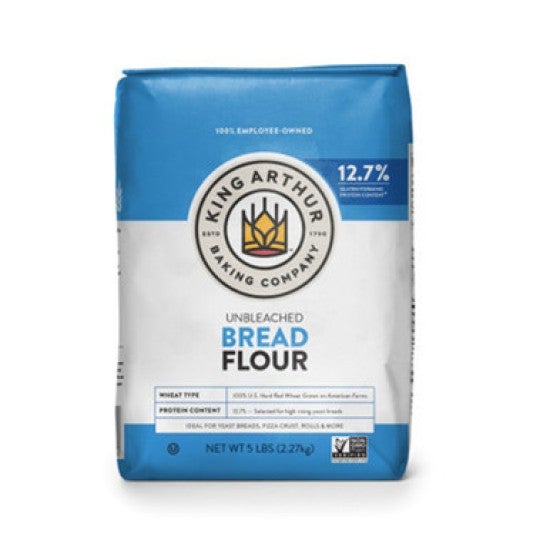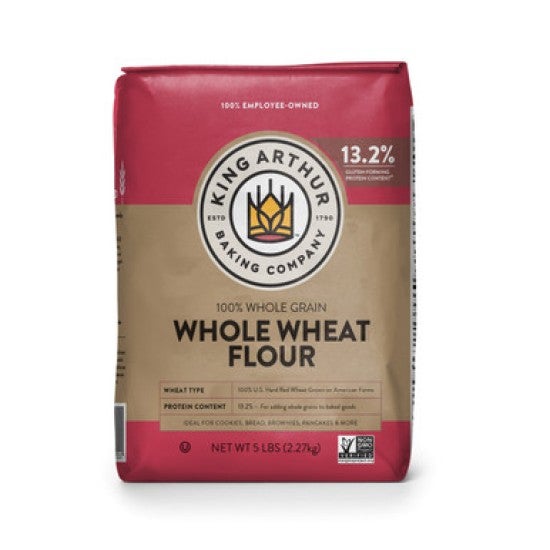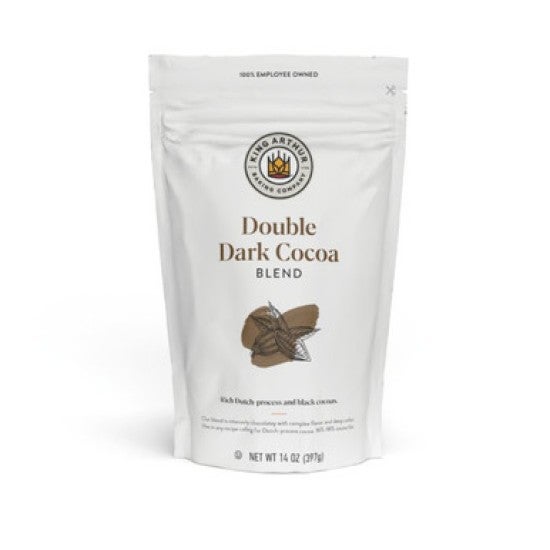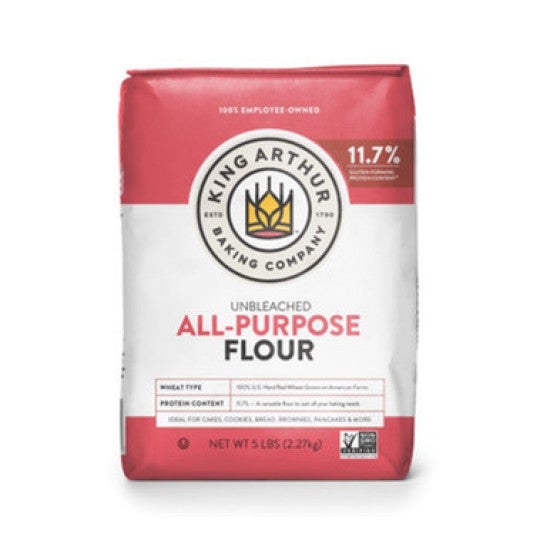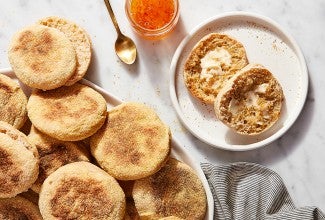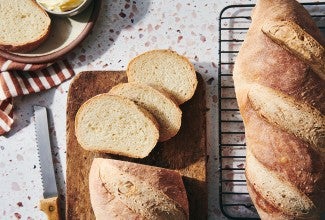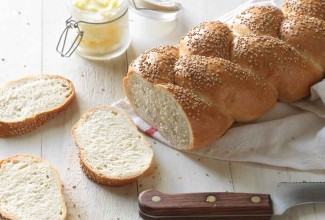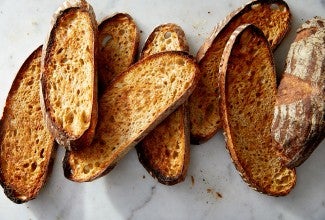-
To refresh your sourdough starter: The night before mixing the dough, discard all but 3 heaping tablespoons (50g) of your sourdough starter. To the starter, add the bread flour and water. Stir vigorously with a spoon or dough whisk, cover with a loose-fitting lid, and leave at room temperature for up to 10 hours, until it's active, bubbly, and has doubled in height. (To see what the starter should look like and for a full walkthrough of the recipe, see our video on how to make Chocolate Beer Bread.)
-
To make the dough: For best results, weigh your flours; this recipe was developed by metric weight. However, if you prefer to work with volume measurements, please be sure to measure your flour the King Arthur way: gently spoon the flour(s) into a cup, then sweep off any excess.
-
In a large bowl, thoroughly mix the flours, cocoa, beer, starter, and salt until there are no patches of dry flour. Squeeze the dough through your hands, like extruding pasta between your fingers to help combine the ingredients. The dough will be sticky, gluey, and shaggy.
-
Use a digital thermometer to take the dough’s temperature — it should be between 75°F and 81°F. (If the dough is above 81°F, stick it in a cool spot — not the refrigerator — until it cools to between 75°F and 78°F. If it is cooler than 75°F, place it in a warm location until it reaches between 75°F and 78°F.) Cover the bowl with a reusable bowl cover (a dinner plate or sheet pan also work) and let rest for 1 hour.
-
To fold the dough: Once the dough is relaxed, perform a series of three folds, each spaced 1 hour apart. To fold, smear a little water onto your work surface. Using a bowl scraper, gather the dough together and turn it out onto the wet table. Using your hands, lift the dough off the table, then slap the bottom half down so that it sticks to the surface. Stretch the dough back toward yourself, then quickly lean forward, folding the dough still in your hands over the portion stuck to the table. (This is known as the “slap and fold” method.) Repeat three to four times. The dough will become smooth and gain strength with each fold.
-
Using the bowl scraper, return the dough to its container smooth-side up, cover, and let rest for 1 hour. Repeat the process two more times, with 1 hour between folding sessions.
-
To preshape the loaf: Lightly dust your work surface with flour. Use a bowl scraper to turn out the dough onto the surface. Pat it into a rectangle with a short side facing you. Bring the bottom edge of the dough towards the top, folding it almost in half but leaving a 1” lip of exposed dough at the top. Gently stretch the sides of the dough outward, then quickly cross them over each other so they overlap, like swaddling a baby. Next, stretch the edge of the dough closest to you up to the top, flush with the top edge. Gently press to create a seam.
-
Use your hands or a bench knife to gently drag the loaf on the table to create surface tension. You will see it tighten and become smooth as you work. Make sure the top stays facing upwards and doesn’t roll over. Sprinkle the dough with flour, cover with a kitchen towel, and let rest 30 minutes.
-
To prepare the oats: While the dough is resting, place a damp kitchen towel over half of a large baking sheet. Toss a handful of rolled oats onto the pan opposite the kitchen towel. Set aside.
-
Lightly dust your work surface and a cloth-lined 9” oval brotform with flour. Use a bench knife to flip over the preshaped loaf so the top is now the bottom. Perform the same motions you used during preshaping: bring the bottom of the dough to meet the top edge, leaving a 1” lip of exposed dough at the top. Gently stretch the sides outward, then quickly cross them over the middle, like swaddling a baby. Stretch the bottom of the dough up to meet the top and seal. The dough will now be a cylinder on its side with a seam facing away from you. Roll the seam underneath and seal the left and right ends using the edge of your palm against the surface.
-
Roll the shaped loaf over the damp towel and through the oats to thoroughly coat the top. Transfer the loaf seam-side up to the floured brotform.
-
Loosely cover the brotform with a reusable cover or kitchen towel and let the dough rise (proof) in a draft-free spot at room temperature for 2 to 3 hours. When fully proofed, the loaf will appear to have doubled in size, feel full of air, and pass the poke test. (See “tips,” below for details.)
-
When proofed, transfer the covered brotform to the fridge for at least 6 hours and up to 24.
-
To bake the loaf: Set up a combo cooker (a cast iron pot and a skillet, both of which have handles and fit together nicely) on a rack in the oven so the skillet is on the bottom and the pot is inverted as its lid.
-
Preheat the oven (and the combo cooker) to 500°F. Alternatively, preheat the oven with a large Dutch oven inside. Wearing welding gloves or working very carefully with heavy-duty oven mitts, remove the combo cooker from the oven (it’s hot!) and quickly invert the cold dough, seam-side down, onto the hot skillet portion of the cooker. Use a lame with the blade at a 35° angle, to score in one long stroke, running lengthwise along the top of the bread.
-
Immediately cover the bread with the inverted pot for a lid and load it back into the oven. Bake for 15 minutes. Remove the combo cooker from the oven and set on the stovetop. Remove the lid (be careful of hot steam) and reduce the oven temperature to 475°F. Return the bread, still on the skillet portion of the combo cooker, to the oven and bake another 15 to 20 minutes, or until the loaf is deeply browned, reaches an internal temperature of 190°F, and sounds hollow when tapped on the bottom. Carefully remove the bread from the skillet and cool completely on a wire rack.
-
Storage information: Store the bread for up to 5 days, cut-side down, in a paper bag tucked inside a cloth bag.
